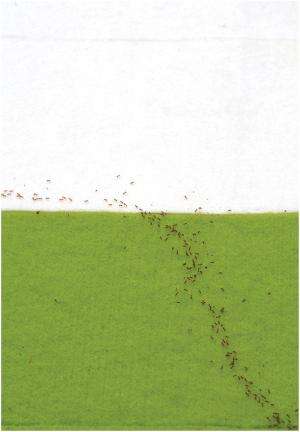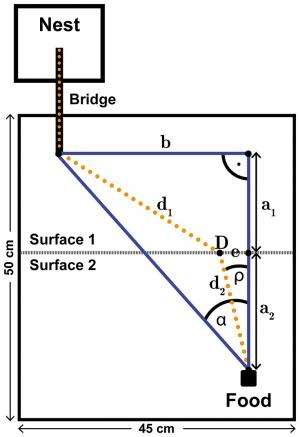April 1, 2013 feature
Ants follow Fermat's principle of least time

(Phys.org) —Ants have long been known to choose the shortest of several routes to a food source, but what happens when the shortest route is not the fastest? This situation can occur, for example, when ants are forced to travel on two different surfaces, where they can walk faster on one surface than on the other. In a new study, scientists have found that ants behave the same way as light does when traveling through different media: both paths obey Fermat's principle of least time, taking the fastest route rather than the most direct one. Besides revealing insight into ant communities, the findings could offer inspiration to researchers working on solving complex problems in robotics, logistics, and information technology.
The researchers, Jan Oettler, et al., from institutions in Germany, France, and China, have published their paper on using Fermat's principle of least time to predict ant trails in a recent issue of PLOS ONE.
The scientists experimentally studied the behavior of the little fire ant, Wasmannia auropunctata, one of the world's 100 most invasive species. They collected three colonies, each containing several thousand workers and multiple queens, from different sites in Israel. They put the ants in plastic boxes without food, and then connected each box to its own foraging arena where cockroaches were provided as food in the corner opposite from the entrance.
The surface of each foraging arena was split in half, and each half was covered by a different material. The researchers experimented with combinations of three materials that differentially affected the ants' average walking speed: rough polyester felt (1.73 mm/s), smooth polyester felt (2.97 mm/s), and polyethylene glass (4.89 mm/s). When ants forage, they deposit pheromones to build a trail, and favorable trails become reinforced with increased usage.
Given the ants' average walking speeds on different materials, along with information on the distances across the foraging arena and the angle defining the shortest path (the straight line) between the entrance and the food, the researchers predicted the angle at which the ants would cross from one surface to the other if they chose the fastest path. In accordance with Fermat's principle of least time, this angle can be thought of as the angle of refraction, similar to how light refracts at a certain angle at the boundary of two media in which it travels at different speeds.

The researchers found that the ants' paths closely matched those predicted by Fermat's principle of least time and did not follow the most direct route. In other words, the ants accounted for the different walking speeds on the different surfaces and traveled a longer distance on the surface where they could walk faster.
"We found that a general rule applies to a dynamic system that relies solely on communication (pheromones) and social cooperation," Oettler told Phys.org. "This system depends on two features. One is routing information that decays over time and needs to be refreshed, thus making the system flexible. And second on behavioral flexibility by the worker ants that carry this information. A path can only be adjusted by worker ants that do not follow this path, but rather take alternative routes (that they advertise), which may be faster (or slower) than the already established path."
Oettler added that the speed with which information decays is crucial to this system, so the results here may be adapted to information routing problems.
The researchers noted that Wasmannia worker ants also resemble humans in this way, since humans have also been found to follow Fermat's principle when forced to cross surfaces with different qualities. One clear example is when a lifeguard has to find the fastest way to traverse both beach and water in order to reach a drowning swimmer.
The researchers also noted that several other factors likely influence why ants choose the paths they do. For instance, the results here suggest that ants prefer to move along edges of borders (in real life, for example, ants are often seen walking along the edges of a sidewalk). Landmarks facilitate orientation, and for ants this could mean that lower amounts of pheromone are needed to mark trails when combined with the physical cues. This is one area that the researchers hope to study more in the future.
"We have only shown the outcome of this process," Oettler said. "In the future we want to study the dynamics of the trail pheromones, their active compounds and evaporation rates. We want to perform behavioral tests with synthetic compounds and detect perception thresholds of individual ants. We also want to study the early dynamics of trail formation over time."
More information: Jan Oettler, et al. "Fermat's Principle of Least Time Predicts Refraction of Ant Trails at Substrate Borders." PLOS ONE. DOI:10.1371/journal.pone.0059739.g001 http://www.plosone.org/article/info%3Adoi%2F10.1371%2Fjournal.pone.0059739
Journal information: PLoS ONE
Copyright 2013 Phys.org
All rights reserved. This material may not be published, broadcast, rewritten or redistributed in whole or part without the express written permission of Phys.org.



















